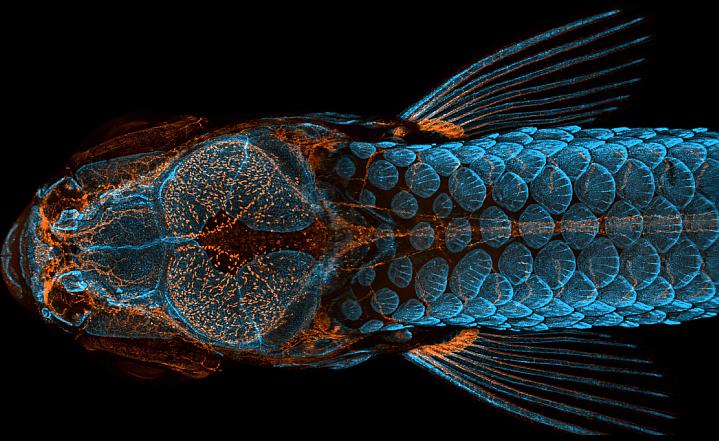In recent decades, zebrafish research studies have led to important insights about cancer, heart disease, and stroke. They’ve also shed light on conditions like anxiety and autism. Zebrafish have even helped scientists find and test potential new drugs.
“Zebrafish are a good model for humans in many ways,” says Dr. Brant Weinstein, an NIH expert in zebrafish biology. “We have a lot of the same genes as zebrafish. We have a lot of the same organs and tissues. And we develop in much the same way, using the same genes and processes.”
In fact, zebrafish and people share more than 70% of their genes. So they’re ideal for studying how various genes can affect the health of both fish and people.
Zebrafish have other traits that are helpful to researchers. They grow up quickly, from a single cell to a free-swimming larval (baby) fish within a few days. And they’re transparent during these early life stages. “You can literally see right through them and watch as all their organs develop,” Weinstein says.
Researchers can add genes that make various tissues glow in a rainbow of colors as the fish mature. “The colors make it easy to track how various tissues grow and change inside living animals,” Weinstein explains.
Scientists can even add genes that make living brain cells glow when they’re active, giving new insights into how the brain works.
Unlike humans, zebrafish can regrow damaged limbs and other body parts. Scientists are working to better understand this ability. What they learn could help to improve human treatments for injuries, burns, and even vision or hearing loss.
“If you uncover a process or treatment that works in zebrafish, that’s a good basis for moving forward to see if the same thing also happens in other animals or even people,” Weinstein says. “The fish can give you early evidence that you’re on the right track—that a particular therapeutic approach might be useful.”
Weinstein and his team study the basic biology of blood vessels. Blood vessels can play roles in heart disease and cancer, because tumors can’t grow without a blood supply. The researchers found a way to block key proteins that fuel the growth of new blood vessels in zebrafish. Then they showed that blocking those proteins in mice could reduce tumor growth. These findings suggest new ideas to improve cancer treatment.
It’s important to uncover such basic processes that are essential to life, even if it doesn’t immediately lead to a new treatment or cure. “We don’t always know where new findings in zebrafish might lead,” Weinstein says. “But they lay the foundation for future discoveries that can improve human health.”
Why Study Zebrafish?
- Transparency. Scientists can watch how the fish’s internal organs grow and change.
- Regeneration. Understanding how fish repair body parts can help improve human treatments.
- Similar genes. Zebrafish can help researchers figure out which genes cause human illness.
- They can glow! Scientists can add genes to zebrafish to make certain cells or tissues glow different colors. This can reveal new details about how tissues and organs develop.




